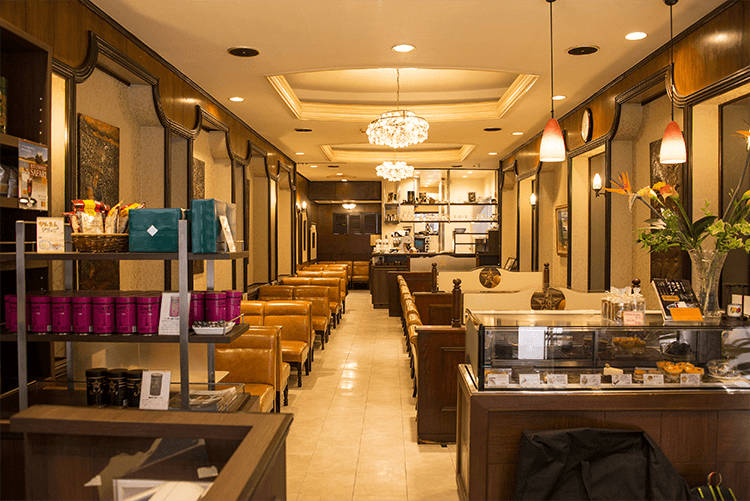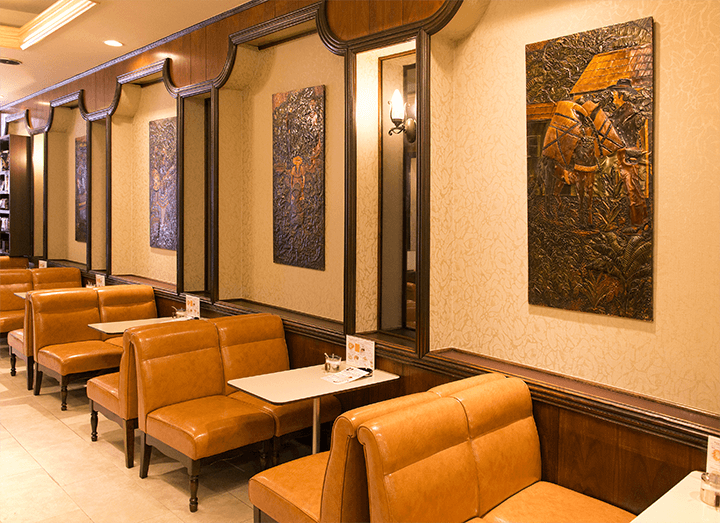
The oldest traditional coffee shop, aka kissaten, still standing in Tokyo is Cafe Paulista, which has a rich and flavourful history. Located in a quiet part of the glamorous district of Ginza, it has been serving Brazilian coffee and light meals since 1911 to some of Japan’s and the world’s elite: Albert Einstein in 1922, John and Yoko Lennon in the 1970’s, and famous Japanese writers including Akutagawa Ryunosuke, the father of the Japanese short story and Yoshii Isamu, the tanka poet and playwright.
-
01
Kissaten vs Cafes
The difference between a kissaten and a cafe is that a cafe, at that time, often sold alcohol as well which meant an increase in noise and rowdiness. The kissaten, the word literally means tea drinking shop, were quieter places for intellectuals and artists to meet and exchange ideas. They were based on the coffee houses of the Parisian elite.
![1st floor entrance includes typical old school features of a kissaten
Photo Credit: Cafe Paulista]()
1st floor entrance includes typical old school features of a kissaten Photo Credit: Cafe Paulista
-
02
Roots in Brazil
At the end of the Russo-Japanese war (1904 - 1905), returning soldiers were faced with unemployment, poor health and hunger. A Japanese businessman, Mizuno Ryo, came up with the idea of sending these men to work on coffee plantations in Brazil, to earn their fortunes and return home, healthy and wealthy. Coffee at that time in Japan was considered a luxury item. Unfortunately, as with all get-rich-quick schemes, the idea is better than the reality. Working on a coffee plantation proved to be a challenging and very difficult life.
![The first group to emigrate to Brazil in 1908
Photo Credit: Cafe Paulista]()
The first group to emigrate to Brazil in 1908 Photo Credit: Cafe Paulista
In 1908, the first group of Japanese emigrated to Brazil with Mizuno securing a deal with the São Paulo government to provide 70kg of free coffee beans for three years, to increase the popularity and consumption of coffee in Japan which as a luxury item at the time was out of reach to most Japanese. Mizuno’s brief was to open coffee shops in Tokyo, Yokohama and other cities using these coffee beans to spread the love. 70kg was seven times the amount of coffee beans being imported at the time, so Mizuno had to develop creative ways to use it all. Initially Mizuno could not get permission from the Japanese government to import the coffee beans, as it wasn’t grown domestically. Colleagues of Mizuno won the argument for him asserting that the consumption of local sugar would increase through the Japanese people drinking this coffee thus benefitting Japan and interestingly making the Japanese people happy by sweetening their lives now and into the future.
![The Cafe Paulista logo
Photo Credit: Cafe Paulista]()
The Cafe Paulista logo Photo Credit: Cafe Paulista
-
03
Cafe Paulista
In 1910 plans for the first cafe began. It was called Paulista as this is the term for a person from São Paulo. People-watching was already a thing then in Ginza, with its unusual large western style stores where you could enter and leave your shoes on. Cafe Paulista, the second cafe to open after Cafe Printemps, used a number of innovative marketing strategies to ensure success as soon as the doors opened.
![Outside the original building in 1911
Photo Credit: Cafe Paulista]()
Outside the original building in 1911 Photo Credit: Cafe Paulista
Firstly, well-dressed, good looking Ginza boys handed out coffee vouchers to passers-by on the street. Secondly educated and beautiful Ginza girls would host events in the homes of upper-class Japanese, teaching the guests how to brew and consume coffee the Brazilian way. Once the cafe opened in 1911, on their busiest days, up to 4,000 cups of Brazilian coffee a day were sold.
It soon became a trend to go to Ginza, grab a cup of Brazilian coffee, mingle with the writers, philosophers and artists of the day and wander around Ginza for no particular reason. A word was coined to describe all this activity: Ginbura - an amalgamation of Ginza and Brazil.
Mizuno opened 22 coffee shops in Japan and one in Shanghai, thus creating one of the first coffee chains in the world and the success of the kissaten Cafe Paulista is thought to have inspired the Japanese to open kissaten all over the country.![First floor
Photo Credit: Cafe Paulista]()
First floor Photo Credit: Cafe Paulista
![Second floor
Photo Credit: Cafe Paulista]()
Second floor Photo Credit: Cafe Paulista
Cafe Paulista in Ginza is spread across two floors. There is Brazilian memorabilia scattered throughout and photos and certificates from its important history gracing the walls, including a photograph of John and Yoko. The cafe serves a variety of light meals - I always eat the quiche and salad - and you can choose different blends of coffee beans from many countries in the world, including, of course, Brazil.
Access: 7 minutes walk from Ginza Station on the Tokyo Metro Ginza, Hibiya and Marunouchi Lines
Address: Nagasaki Centre Building 1F and 2F, 8-9-16 Ginza, Chuo-ku, Tokyo 104-0061
Opening Hours: Monday - Saturday 9am - 8pm; Sunday 11:30am - 7pm. Check website for national holiday hours- Cafe Paulista (Ginza Main Shop)
-
4.0
71 Reviews -
-
- Tokyo Chuou-ku Ginza 8-9 Nagasaki Center Building 1F
-
-
-
- 0335726160
-
-
-
- [Monday-Saturday]9:00-20:00[…
-
View All







 Go here
Go here





